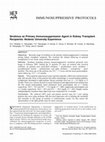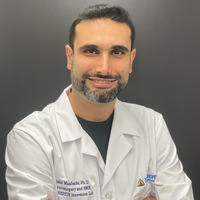Papers by Kamil Yakupoglu
European Urology Supplements, 2009
Primary testicular leiomyosarcoma is an extremely rare tumor, and, to the best of our knowledge, ... more Primary testicular leiomyosarcoma is an extremely rare tumor, and, to the best of our knowledge, only 20 cases in adults have been reported in the literature to date. Herein, we present a case of a 68-year-old man who complained of left scrotal swelling for 2 months. Radiological examination revealed a left testicular tumor with no metastases to other organs. A left inguinal orchiectomy was carried out and histopathologic examination revealed an intratesticular leiomyosarcoma. The patient was treated successfully by orchiectomy and received no adjuvant therapy. During follow up until 12 months after surgery, there has been no recurrence or metastases of the disease.

Diagnostic Pathology
Background Desmoplastic small round cell tumor (DSRCT) is a rare, aggressive neoplasm seen in chi... more Background Desmoplastic small round cell tumor (DSRCT) is a rare, aggressive neoplasm seen in children and young adults, usually manifested by involvement of abdominal serosa. Here, we present an unusual case of primary DSRCT of kidney. Case presentation The patient was an 8-year-old girl with a large renal mass which was confused with primitive neuroectodermal tumor (PNET) in the needle biopsy. The tumor had a variegated histology revealing frequent pseudo-rosette formations, pseudopapillary architecture, rhabdoid, clear or pleomorphic cells in addition to typical small round cell morphology and desmoplasia. It showed immunohistochemical features of DSRCT, and EWSR1 re-arrangement. Conclusions Proffering this diagnosis is particularly difficult for tumors of viscera because of the incognizance of the entity in these locations. Moreover, DSRCT is a great mimicker and may get easily confused with more common kidney malignancies of childhood such as Wilms tumor, PNET/EWS, rhabdoid tum...

Pediatric Transplantation
Renal transplant recipients are on long‐term potent immunosuppressive therapy, which makes them h... more Renal transplant recipients are on long‐term potent immunosuppressive therapy, which makes them highly vulnerable to opportunistic fungal infections. Dematiaceous, or dark‐pigmented saprophytic fungi, are being increasingly seen as opportunistic pathogens of mycoses in immunosuppressed patients. One of these is Aureobasidium pullulans, which is a black yeast‐like dematiaceous fungus found ubiquitously in the environment that can cause various opportunistic human infections. Most infections occur by traumatic inoculation, such as keratitis and cutaneous lesions; disseminated mycoses are very rare and occur only in severely immunocompromised patients. We report a case of disseminated fungal infection due to A. pullulans in a pediatric patient who underwent renal transplant. The use of voriconazole and vacuum‐assisted closure along with surgical drainage most likely contributed to the patient's positive outcome.
Transplant …, 2006
We compared the incidence of urological and anastomotic complications for the ureteroureterostomy... more We compared the incidence of urological and anastomotic complications for the ureteroureterostomy and Lich–Gregoir techniques in kidney transplant recipients. Between May 2003 and February 2004, 75 kidney transplant recipients from living donors were ...
Journal of Laparoendoscopic & Advanced Surgical Techniques
Journal of Laparoendoscopic & Advanced Surgical Techniques

Journal of Urological Surgery
The increased number of successfully performed kidney transplantations increases, life expectancy... more The increased number of successfully performed kidney transplantations increases, life expectancy and the chance for urologists to treat urothelial carcinoma (UC) in kidney transplant (KTs) recipients. In this non-randomized retrospective single-center study, the authors aimed to investigate the incidence of UC by calculating age-standardized rates (ASRs) in 2186 KT recipients and the general population and to determine the treatment outcomes. ASRs of bladder cancer and upper urinary tract UC (UTUC) in KT recipients were 25.5 and 129.5 times higher than that in the general population and the proportion of female UC patients was 2.5 times higher, reflecting a reversed gender disparity. No significant difference was observed in treatment outcomes between KT recipients and non-KT patient, however, the rate of progression to bladder cancer was higher with a relative risk of 10.53 (p=0.0481) compared to the general population. In the light of these data, urologic screening, and active treatment should be offered to identify the UC cases in KT recipients.

Journal of Urological Surgery
Urinary tract infections (UTIs) are the most common bacterial infections observed after kidney tr... more Urinary tract infections (UTIs) are the most common bacterial infections observed after kidney transplantation. Urinary catheters impregnated with antimicrobials, can inhibit or delay pathogen colonization and may contribute to infection prevention. However most studies comparing catheters impregnated with antimicrobials exclude immunosuppressed patients, such as kidney transplant recipients. In this pilot, single-centre, open-label, randomised controlled trial authors have tested whether Nitrofurazone-coated silicone urinary catheters reduced asymptomatic bacteriuria and UTIs in adult living donor kidney transplant recipients. Two hundred fourteen living donor kidney transplant recipients were randomised in a 1:1 ratio with a computer-generated system to a Nitrofurazone-coated silicone urinary catheter and non-impregnated silicone urinary catheter of whom 176 completed the study. There were no differences between groups in the reduction of asymptomatic bacteriuria and UTIs. Patients reported higher levels of discomfort and side effects with the use of Nitrofurazone-coated catheter (46.6% vs 38.9%, p=0.007). The results of this study do not suggest the use of Nitrofurazone-coated silicone urinary catheters in this population.
European Urology Supplements, 2012

European Urology Supplements, 2011
Due to concerns of senior surgeons PNL training rarely contains compared to open surgeries during... more Due to concerns of senior surgeons PNL training rarely contains compared to open surgeries during residency training. In this study we evaluate the effects of the urology specialists and residents of different levels of experience to the PNL results. Materials & Methods: The 177 patients who underwent PNL applications between January 2009 and July 2010 in our clinic were evaluated. The surgeons were divided into three distinct groups similar to previous studies. Experience with more than 250 first group, second group surgeon with experience of >100 cases. The third group surgeons were residents with less then these or minimal experience. 12 urologists and urology residents (GI:1, GII:2, GIII:9) were included to the study. Different features of the interventions were compared between groups. Complications were given according to Clavien classification. results: The mean operative time and FST of the residents (Group III) were significantly longer compared to that of the expert surgeon (101/125 min p=0.017 vs. 191/327 sec, p=0.000). The mean age of the patients was lower in Group I. The mean stone burden and complex stone ratio were higher, other hand the mean renal access number was lower in Group I and II than Group III. Stone free rate, bleeding, hospitalization and complications did not differ significantly between these groups. Conclusions: Despite the longer operation time and FST, urology residents under the supervision of senior surgeons can perform PNL for kidney stones that we found often in our country with the comparable success and complication rates with the literature.
European Urology Supplements, 2011
Nevertheless, we believe that even though it is not mandatory for any endourologist to adopt the ... more Nevertheless, we believe that even though it is not mandatory for any endourologist to adopt the supine position, this position is definitely here to stay and should be considered the position of choice during endourological training.

Transplantation Proceedings, 2005
Objectives. Recently usage of sirolimus as the primary immunosuppressant is widening among kidney... more Objectives. Recently usage of sirolimus as the primary immunosuppressant is widening among kidney transplant recipients. We reviewed the clinical follow-up of patients transplanted at our center using sirolimus protocols. Methods. Sirolimus including primary immunosuppressive treatment protocols were begun in February 2002. Among the 21 patients (15 men, six women) who received sirolimus, six patients were prescribed sirolimus ϩ prednisolone; seven, sirolimus ϩ mycophenolate mofetil ϩ prednisolone; and eight, sirolimus ϩ cyclosporine ϩ prednisolone. The mean age of the patients was 32.9 Ϯ 7.3 years and the mean posttransplantation follow-up, 13.2 Ϯ 4.5 months. Results. Three patients experienced acute rejection episodes, which were treated successfully with steroids. None of the patients had either hematologic or wound healing problems. Lymphoceles developed in eight patients. Serum creatinine level was 1.4 Ϯ 0.5 mg/dL at 12 months. There was a serious increase in serum cholesterol and triglyceride levels starting from the first month posttransplant (total cholesterol levels pretransplant and at 1 month, respectively: 159.3 Ϯ 29.5 and 255.7 Ϯ 52.3 mg/dL, P ϭ .0001; triglycerides pretransplant and at 1 month, respectively: 146.9 Ϯ 89.5 and 215.1 Ϯ 102.5 mg/dL, P ϭ .001). Despite routine antihyperlipemic treatment those high levels were maintained for 12 months. Conclusions. We achieved 100% graft and patient survival rates for 1 year among patients who were using sirolimus. But the most important role in defining the morbidity and mortality in this group of patients is cardiovascular events; for this reason the abnormalities in the lipid profile must be taken seriously.

Transplantation Proceedings, 2006
Objective. We examined the occurrence of neoplasms among 1008 renal transplant recipients treated... more Objective. We examined the occurrence of neoplasms among 1008 renal transplant recipients treated with a sirolimus-cyclosporine (CsA) Ϯ prednisone (Pred) regimen. Methods. A comprehensive database of demographic, laboratory, clinical, and histopathologic features of these patients all followed in our transplant center was analyzed using Student t test and Mann-Whitney U test for continuous and chi-square test for categorical variables. Comparisons were performed with information in the Israel Penn International Transplant Tumor Registry (IPITTR). Results. During the mean patient follow-up of 62.3 Ϯ 26.1 months (range 27.1 to 131), 36 tumors occurred in 35 patients (3.6%) at 32.5 Ϯ 29.8 months. The most common neoplasms were skin tumors (2.4%), a value that was significantly lower than the 6% rate observed with CsA-azathioprine-Pred treatment. Also, the 0.4% incidence of posttransplant lymphoproliferative disorders and 0.2% incidence of renal cell carcinomas were less than half of those previously reported with a combination of tacrolimus and mycophenolate mofetil. The distribution of tumor types was similar to that reported to the IPITTR. The mean trough drug concentrations in affected recipients at the time of diagnosis were within the putative target ranges. Conclusion. Renal transplant recipients treated with the sirolimus-CsA Ϯ Pred combination showed a low incidence of tumors of similar types as those encountered with other regimens.

The shortage of donor organ supply is forcing patients with end-stage renal disease to alternativ... more The shortage of donor organ supply is forcing patients with end-stage renal disease to alternative searches. The aim of this study is to present the clinical and laboratory data of five patients who were transplanted in Egypt from paid living-unrelated donors and followed at our institution. Five patients (four male, one female, mean age 51 yr) were included in this retrospective study. All allografts still have good function with a mean serum creatinine level of 0.9 mg/dL. Surgical and medical problems were common such as wound infection (n = 3), evisceration (n = 2), deep vein thrombosis (n = 2), unexplained abdominal incision requiring removal of an abdominal surgical compress left in situ during previous surgery, placement of allograft on the side of an unrepaired indirect inguinal hernia and transplant pyelonephritis. Although recent developments increased success in renal transplantation, receiving a kidney from a paid living donor at a commercial transplant center still carries great risks for the recipient.

Urologia Internationalis, 2016
The objective of this study is to present the experience of 3 institutions performing renal autot... more The objective of this study is to present the experience of 3 institutions performing renal autotransplantation (RAT) and to discuss surgical techniques employed and the results in the light of the medical literature. A total of 14 patients (11 male and 3 female) with a mean age of 47 ± 8 years (35-61 years), who underwent RAT procedure at 3 different institutions between October 2006 and November 2014, in Turkey, were evaluated retrospectively. Indications for RAT procedure are ureteral avulsion, renal artery aneurysm and intimal dissection caused by percutaneous transluminal renal artery angioplasty (PTRA). Twelve patients with ureteral avulsion, 1 patient with renal artery aneurysm and 1 patient with intimal dissection caused by PTRA were followed-up for 103 months. Seven (50%) open and 7 (50%) laparoscopic nephrectomies were performed. Nine patients (64.3%) were right-sided and 5 patients (35.7%) were left-sided. Complications of grade III and above as per Clavien-Dindo classification were assessed. Mean time from injury to RAT was 21.2 ± 40.1 days. However, 5 (35.7%) patients were treated on the same day of the injury. As per Clavien-Dindo classification, 2 (14.2%) grade IVa and 1 (7.1%) grade IIIa complications were reported. However, no significant correlation was observed between the complications and graft loss regarding type and side of the nephrectomy performed (p = 0.462 and p = 0.505, respectively) and timing of the intervention (p = 0.692). RAT is a safe procedure in combination with minimally invasive laparoscopic technique in carefully selected patients; however, it requires expertise and proficiency in laparoscopy, reconstructive urology and transplantation. Nevertheless RAT should be considered as the last resort, when other modalities fail.

Experimental and Clinical Transplantation Official Journal of the Middle East Society For Organ Transplantation, Jun 1, 2003
Sirolimus, a macrocyclic lactone that displays a novel mechanism of immunosuppressive action, is ... more Sirolimus, a macrocyclic lactone that displays a novel mechanism of immunosuppressive action, is a critical-dose drug requiring therapeutic drug monitoring for optimal outcomes. The compound was documented in two multicenter, blinded clinical trials to reduce the incidence of acute rejection episodes when used in combination with cyclosporine and steroids vs. azathioprine or placebo comparators. Furthermore, studies utilizing cyclosporine withdrawal documented a long-term benefit on renal function of chronic sirolimus therapy, albeit with a modestly enhanced incidence of acute rejection episodes. Although this application may be useful in selected cases, we believe that minimal initial cyclosporine exposures de novo mitigate the need for eventual withdrawal for chronic nephropathy, while preserving the immunosuppressive synergy during the maintenance phase. Recipients treated de novo with a sirolimus-cyclosporine combination tolerate steroid withdrawal at 1 month after living-donor or at 3 to 6 months after cadaveric kidney transplantation with only a 5% risk of acute rejection episodes and 6% incidence of chronic reactions within 3 years. However, sirolimus exacerbates the hypertriglyceridemic and hypercholesterolemic proclivities of transplant recipients, as well as exerts myelosuppressive effects, which are augmented by concomitant therapy with azathioprine or, particularly, with mycophenolate mofetil. Due to its apparent lack of nephrotoxicity, sirolimus has been employed for induction therapy in a calcineurin antagonist-free regimen in combination with either basiliximab or rabbit antilymphocyte sera for weak or strong immune responders, respectively, followed by introduction of a calcineurin antagonist upon resolution of the ischemia-reperfusion injury. Therefore, sirolimus proffers a potent and unique platform for new immunosuppressive strategies in organ transplantation.
Urology, 2015
Metanephric adenoma (MA) is an epithelial benign tumor of the kidney and very rare in children. H... more Metanephric adenoma (MA) is an epithelial benign tumor of the kidney and very rare in children. Here we present 2 cases of MA treated by laparoscopic nephron-sparing surgery in children. To the best of our knowledge, we report the first cases of laparoscopic nephron-sparing surgery for MA in children.









Uploads
Papers by Kamil Yakupoglu